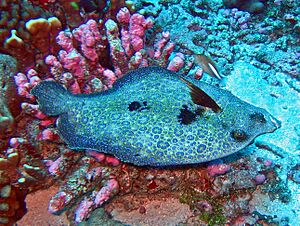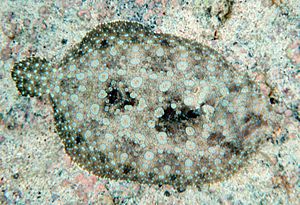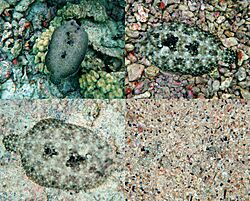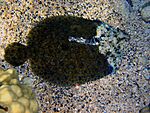Peacock flounder facts for kids
Quick facts for kids Peacock flounder |
|
|---|---|
 |
|
| Bothus mancus in Polynesia | |
| Conservation status | |
| Scientific classification |
The peacock flounder (Bothus mancus) is a cool fish. It's also called the flowery flounder because of its pretty spots. This fish belongs to a group called Bothidae, which are known as lefteye flounders. You can find peacock flounders in warm, shallow waters across the Indo-Pacific and eastern Pacific oceans.
Contents
About the Peacock Flounder
The peacock flounder gets its "flowery" name from the bluish spots that look a bit like flowers. These fish are special because both of their eyes are on the left side of their head. This is why they are called "lefteye" flounders.
Their eyes are super unique! They stick up on short stalks, almost like tiny radar dishes. Each eye can move in any direction all by itself. This means one eye can look forward while the other looks backward at the same time. This gives the flounder a very wide view of its surroundings.
When peacock flounders are babies, they look like regular fish with one eye on each side. They swim upright, just like most fish. But as they grow up, their right eye slowly moves over to the left side of their head. Once both eyes are on one side, they start swimming sideways. This helps them lie flat on the ocean floor. A full-grown peacock flounder can be about 45 centimetres (18 in) long.
Where They Live
Peacock flounders mostly live in shallow ocean waters. They prefer sandy bottoms where they can easily hide. Sometimes, you might spot them resting on piles of dead coral or bare rocks. They can live in waters as deep as 150 meters (490 ft).
Peacock Flounder Behavior
What They Eat
Peacock flounders are usually active at night, but sometimes they hunt during the day too. They are predators, meaning they hunt other animals for food. Their favorite meals include small fish, crabs, and shrimp.
Life Cycle
Peacock flounders usually breed in late winter and early spring. The female flounder releases millions of tiny eggs, sometimes two to three million at once! Then, the male fertilizes these eggs.
The fertilized eggs float near the surface of the water. Ocean currents carry them far away. After about 15 days, the eggs sink to the bottom and hatch. Baby flounders then float in the open ocean for four to six months. During this time, their right eye slowly moves to the left side of their head.
Amazing Color Change
Peacock flounders are true masters of camouflage. This means they are super good at blending in with their surroundings. They use their amazing colors and patterns to hide from both the animals they hunt and the animals that might hunt them.
Instead of swimming, they often crawl along the bottom using their fins. As they move, they constantly change their colors and patterns to match the ground below them. Scientists have seen peacock flounders change their colors in as little as eight seconds! They were even able to match the pattern of a checkerboard they were placed on.
This color change is a very complex process. It involves the flounder's vision and special chemicals called hormones. The flounder releases different pigments to the surface of its skin cells. Some cells are left white, while others get colored to match the environment. If one of a flounder's eyes is hurt or covered by sand, it has a hard time matching its colors.
When hunting or hiding, flounders often bury themselves in the sand. They leave only their eyes sticking out, watching everything around them.





